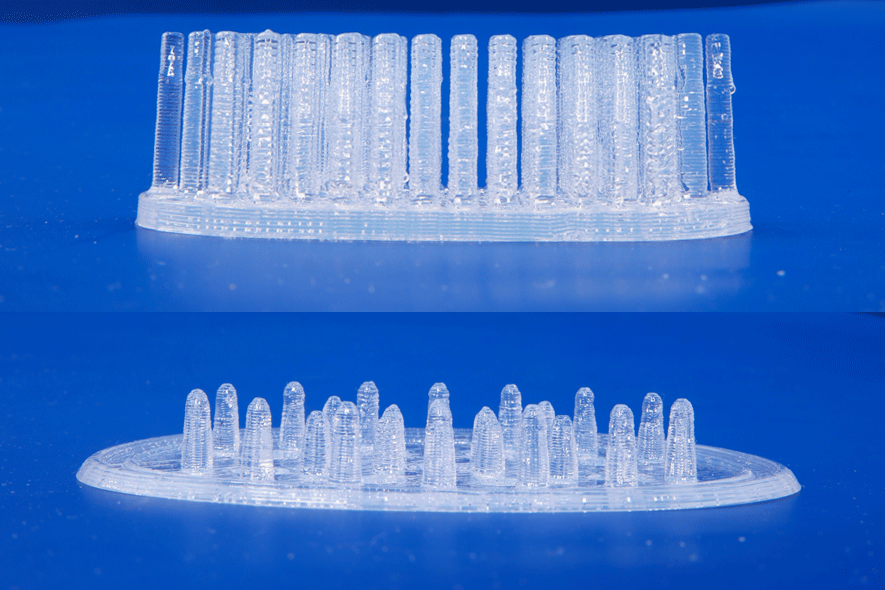
Liquid Additive Manufacturing (LAM) impresses clients with high process speed, distortion-free printing, and almost limitless freedom of form. In addition, the technical properties of the system correspond to those of traditional manufacturing processes. The innovative processing method is suitable for prototypes as well as for industrial small series. As a result, this additive manufacturing process is gaining relevance in a wide variety of industries and application areas.
As inspiration for what is possible with the LAM 3D printer LiQ 320 from German RepRap, here we will provide some examples.
Industry
The need for industrial seals made of liquid silicone rubber is almost endless. Seals are getting smaller and smaller, and shapes are getting more and more complex – and, in some cases, with a batch size of just one. With the LiQ 320, manufacturers can adapt quickly to this development.
Thanks to this innovative technology, seals can be designed and produced very fast without the long set-up times and high costs associated with injection moulding.
From micro seals for electronic devices to profiled window seals and classic ring seals, many items can be realized with additive manufacturing. It is even possible to print a silicone seal directly onto an existing component. To do this, the object is placed in the printer and the silicone is applied directly to it and cured. The only restriction is that the component must be temperature-resistant, as the thermal cross-linking of the silicone takes place during the printing process using a high-temperature halogen lamp.
Healthcare and medicine

L-R: 3D printed silicone mouth-nose mask (Image courtesy of Yamaichi Special Steel / Rhushik Matroja); silicone ear plugs (Image courtesy of Yamaichi Special Steel / Akihiko Sakamoto); and silicone insoles (Image courtesy of German RepRap).
Thanks to its outstanding properties, silicone has gained a firm foothold in the medical sector. Since customization also plays a major role in this field, the LiQ 320 is predestined for such applications.
The following two examples come from our partner Yamaichi Special Steel:
The mouth-nose mask is quite timely for this pandemic year 2020, and is exceedingly practical, convenient, and sustainable. Only a thin paper filter is inserted into the silicone mask. The mask itself is produced in a very short time with minimal use of materials – and in various sizes. Whether child or adult, narrow- or wide-faced, there is a mask for everyone that fits and is comfortable.
Another example, silicone earplugs, are similar to the mouth-nose mask in terms of time and cost. In addition, they can be easily customized to fit any ear canal.
Yet another example was realized in cooperation with DOW and the shoe manufacturer ECCO: silicone insoles for shoes that are ergonomically adapted to the respective foot. Here, too, the consistently positive properties of silicone rubber come into play. The cushioning properties of the sole remain as they were on the first day, even after countless miles.
Wellness
Whether for scalp massages or facial cleansing, silicone brushes have become an indispensable part of the wellness sector. The fine brush structures can also be optimally produced with Liquid Additive Manufacturing. And more than that, the diameter of the individual bristles can be adjusted virtually in the blink of an eye, as can the size of the entire brush and the basic shape.
Everyday life
Our final example falls into the realm of everyday objects and is kind of a mesh shopping bag, produced by our partner Hotty Polymer. The bag is lightweight, flexible, handy as well es robust: because, as mentioned at the beginning, the technical properties of LAM correspond to those of traditional manufacturing processes.
As with all additive manufacturing processes, the prerequisite for a good result is that the component is additively designed or redesigned and the printing parameters are optimized for the printing job. Therefore, German RepRap sees itself as a long-term partner for its customers: Whether it’s the sales team, application specialists or colleagues from the service department – our employees are always available as contact persons with their extensive knowledge and years of experience.
Subscribe to Our Email Newsletter
Stay up-to-date on all the latest news from the 3D printing industry and receive information and offers from third party vendors.
Print Services
Upload your 3D Models and get them printed quickly and efficiently.
You May Also Like
Heating Up: 3D Systems’ Scott Green Discusses 3D Printing’s Potential in the Data Center Industry
The relentless rise of NVIDIA, the steadily increasing pledges of major private and public investments in national infrastructure projects around the world, and the general cultural obsession with AI have...
3DPOD 260: John Hart on VulcanForms, MIT, Desktop Metal and More
John Hart is a Professor at MIT; he´s also the director of the Laboratory for Manufacturing and Productivity as well as the director of the Center for Advanced Production Technologies....
Etsy Design Rule Change Reduces Selection of 3D Printed Goods
Online marketplace Etsy has implemented a rule change requiring all 3D printed goods on the site to be original designs. The update to the site’s Creativity Standards states, ¨Items produced using...
E-Beam OEM Wayland Additive Partners with USC Racing to 3D Print Titanium Exhaust Collector
Every year, standards organization SAE International holds a competition called Formula SAE, in which students from both undergraduate and graduate programs design, build, and race small formula-style race cars. For...




































